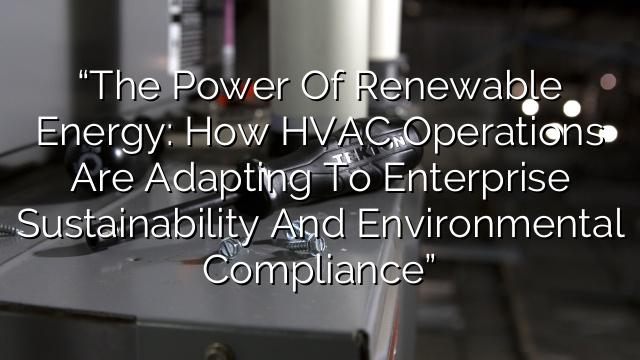Why Enterprise Sustainability Matters
Sustainability is no longer a buzzword or an optional corporate initiative. With the mounting evidence of climate change and its impacts on the planet, incorporating eco-friendly measures into business operations isn’t just a socially responsible choice, it’s an economic imperative. Today’s consumers are highly aware and concerned about environmental issues, often basing their purchasing decisions on a company’s eco-initiatives. Moreover, sustainable practices often lead to cost savings by reducing waste and energy consumption, providing a competitive edge in the marketplace.
The Benefits of Eco-Friendly Business Practices
- Reduced Environmental Impact: By implementing eco-friendly measures, enterprises can significantly lower their carbon footprint and reduce strain on natural resources.
- Cost Savings: Green initiatives often result in decreased operational costs due to energy efficiency, reduced material waste, and less water consumption.
- Increase in Consumer Trust: Eco-conscious consumers are more likely to trust and remain loyal to brands that prioritize sustainability.
- Regulatory Compliance: Many regions have established environmental regulations that businesses must adhere to or face penalties.
- Innovation and Market Opportunities: Sustainable practices can lead to the development of new products and services catering to a growing eco-aware market.
Creating a Sustainable Business Roadmap
To achieve sustainability, enterprises must create a strategic roadmap that integrates eco-friendly measures into all aspects of the business. Here’s a step-by-step guide:
Step 1: Assessing the Current Impact
Begin by conducting a thorough assessment of your business’s current environmental impact. Consider energy usage, water consumption, waste production, supply chain operations, and product lifecycle. Third-party auditors can provide an unbiased analysis and identify key areas for improvement.
Step 2: Setting Clear Objectives
- Set attainable goals based on your assessment. Objectives might include reducing greenhouse gas emissions by a certain percentage, minimizing water usage, or increasing the recyclability of your products.
- Ensure that these goals are Specific, Measurable, Achievable, Relevant, and Time-bound (SMART).
- Engagement from all levels of the organization is crucial for goal-setting to be successful.
Step 3: Implementing Green Policies
Adopt and enforce policies that actively promote eco-friendly practices. This could involve:
- Implementing a company-wide recycling program.
- Switching to renewable energy sources.
- Opting for sustainable materials in your products and packaging.
- Investing in energy-efficient equipment and technologies.
Step 4: Employee Engagement and Training
Involve employees in your sustainability efforts:
- Provide training and resources to help staff understand the importance of sustainability and how they can contribute.
- Establish green teams or sustainability committees to drive initiatives and engage their peers.
- Incorporate sustainability objectives into employee performance evaluations and incentive programs.
Step 5: Green Procurement and Supply Chain Management
Look beyond your internal operations and consider the environmental practices of your suppliers:
- Select vendors who also commit to sustainability by adopting green procurement policies.
- Work with suppliers to reduce packaging and optimize transportation efficiency, reducing the overall carbon footprint of your supply chain.
- Incorporate environmental clauses into contracts to ensure alignment of eco-friendly values and practices.
Step 6: Transparent Reporting and Consumer Engagement
Transparency is key to building trust with consumers and stakeholders:
- Publish regular sustainability reports detailing your environmental initiatives and progress towards goals.
- Engage with consumers through marketing campaigns focused on your company’s eco-friendly measures.
- Consider certifications or eco-labels that authenticate your commitment to sustainability.
Step 7: Continuous Improvement and Innovation
Finally, sustainability is an ongoing journey:
- Review and adjust goals as needed to keep pace with evolving best practices in sustainability.
- Stay updated on new technologies and processes that could further reduce your environmental footprint.
- Encourage innovation within the company by rewarding ideas that contribute to your sustainability objectives.
Key Areas for Eco-Friendly Measures
Energy Efficiency
Implementing energy-saving technologies and optimizing operations to reduce consumption can yield significant environmental and economic benefits.
Waste Reduction
Focusing on reducing, reusing, and recycling can minimize waste, save money, and lower your environmental impact.
Water Conservation
Adopting strategies to minimize water use aligns with global efforts to protect this essential resource.
Sustainable Sourcing
Ensuring that the materials and products you use are sustainably sourced supports a circular economy and reduces environmental degradation.
Eco-friendly Packaging
Moving toward biodegradable, recyclable, or compostable packaging reduces pollution and appeals to environmentally conscious consumers.
Investment in Renewable Energy
Investing in renewable energy sources, like solar or wind power, significantly reduces reliance on fossil fuels and helps combat climate change.
Frequently Asked Questions
Why is sustainability important for enterprises?
Sustainability is crucial for enterprises to reduce their environmental impact, cut costs, build consumer trust, and ensure compliance with regulations. It also opens up new markets and drives innovation.
How can businesses begin to implement sustainability measures?
Businesses can start by assessing their current environmental impact, setting clear goals, implementing green policies, engaging employees, managing their supply chain sustainably, reporting transparently, and focusing on continuous improvement.
What are the benefits of transparency in sustainability efforts?
Transparency builds trust with consumers and stakeholders, differentiates your brand, and can lead to increased customer loyalty and business opportunities.
Can sustainability initiatives really save businesses money?
Yes, sustainability initiatives can lead to significant cost savings by improving energy efficiency, reducing waste, and conserving resources.
What is the role of innovation in sustainability?
Innovation is essential for sustainability as it leads to the development of new products, services, and processes that reduce environmental impact and lead to economic growth.







